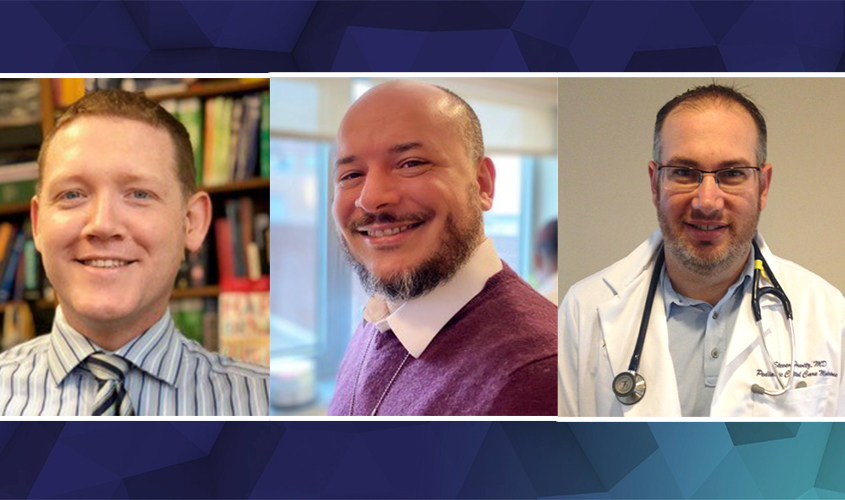What Is Multisystem Inflammatory Syndrome in Children (MIS-C)? Q&A with SGU Grads Featured in New England Journal of Medicine Article (UPDATED)

This article has been updated from its original publication date of September 29, 2020, to name additional SGU graduates who contributed to the New England Journal of Medicine article.
As the novel coronavirus (COVID-19) continues to affect persons young and old, and increasingly in children, the New England Journal of Medicine recently published an article titled “Multisystem Inflammatory Syndrome in U.S. Children and Adolescents.”
Among the nearly 50 contributing physicians, five were St. George’s University graduates:
- Steven Horwitz, MD ’08, a lead author on the paper who is a pediatric critical care specialist and assistant professor of pediatrics at Rutgers University School of Medicine;
- Michael Keenaghan, MD ’06, the associate chief academic officer at New York City Health+Hospitals/Kings County;
- Hussam Alharash, MD ’11, a pediatric intensivist and informatics liaison at New York City Health+Hospitals/Kings County;
- Shira Gertz, MD ’01, FAAP, an attending physician in pediatric critical care at Saint Barnabas Medical Center in Livingston, NJ, and clinical associate professor in the Department of Pediatrics at Rutgers New Jersey Medical School; and
- Stacy Ramsingh, MD ’15, a third-year pediatric ICU fellow at Advocate Children’s Hospital in Park Ridge, IL.
SGU spoke with three of the SGU-educated doctors to get their take on the article’s findings, and why the research was an important contribution to the expansion of medical knowledge of COVID-19.
St. George’s University: As COVID continues to affect adults and children, what is MIS-C and why is it an important disease to understand?
Drs. Horwitz, Keenaghan, and Alharash: Multisystem inflammatory syndrome in children (MIS-C) is a newly identified inflammatory syndrome affecting children, that is associated with SARS-CoV-2019 infection. The pathophysiology is not clear at this point, and there is much we do not yet know about the long-term prognosis. Some of the children who present with this syndrome are very sick and require ICU-level care, while others have very mild symptoms.
There are several reasons why it is important to understand this disease: Because MIS-C in some ways mimics the presentation of Kawasaki disease, pediatricians are concerned that some of the same sequelae and complications of Kawasaki may develop in children who are diagnosed with MIS-C. We know that some of the children who present with MIS-C are very sick, and since it is unlikely that COVID-19 will disappear in the immediate future, there is a lot of interest in better understanding it and its long-term complications.
SGU: What was the research intending to prove?
Drs. Horwitz, Keenaghan, and Alharash: The study we were involved in aimed to describe the presentation and inpatient course of MIS-C. By looking at a series of patients and characterizing some of the disease’s features, the paper should give clinicians who have not yet seen patients of MIS-C an idea of what to look for and what to expect. It will also help to characterize and pin down the definition of the syndrome, which will help in ongoing research that looks at MISC.
SGU: What were the key findings? Why were the results significant?
Drs. Horwitz, Keenaghan, and Alharash: The study confirmed what many of us suspected. MIS-C was causing cardiovascular symptoms, gastrointestinal symptoms, hematologic abnormalities, and was associated with markedly elevated signs of inflammation.
It also reassured us in some ways because it demonstrated that while a good number of the patients with MIS-C required cardiovascular support in the form of vasopressors and in a few rare occasions extracorporeal membrane oxygenation (ECMO), the vast majority of these kids got better and went home.
SGU: What exactly was your part in the research efforts?
Drs. Horwitz, Keenaghan, and Alharash: As the pandemic took hold in the United States, the Northeast and New York City, in particular, were the epicenter of the new cases of COVID and eventually of MIS-C cases as well. Our contribution to this project was to review the patients at our hospitals who presented with features of what would eventually come to be called MIS-C and prepare detailed case reports about the presentation and hospital course for each of the patients. This data was later included in the multicenter analysis that resulted in the publication in the New England Journal of Medicine.
SGU: What practical advice would you give to medical students who want to get research published?
Drs. Horwitz, Keenaghan, and Alharash: Be curious and follow through. There is much we do not know in medicine—being curious will make it more likely that you will become familiar with the questions that are waiting to be answered. Of course, coming up with the question is just the start. Research can be a very long and drawn-out process with many setbacks. Perseverance and follow-through in the face of adversity will be required to keep going.
— Laurie Chartorynsky

